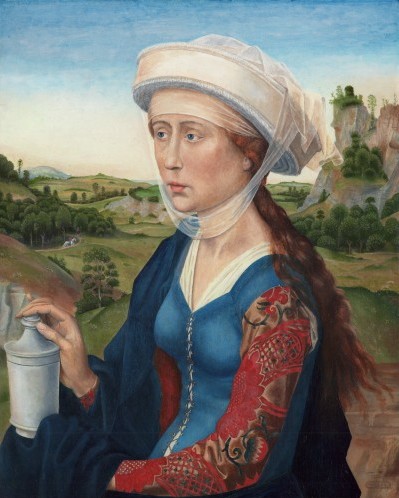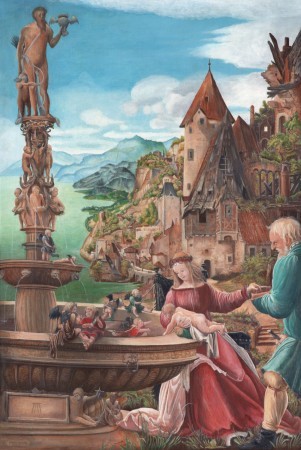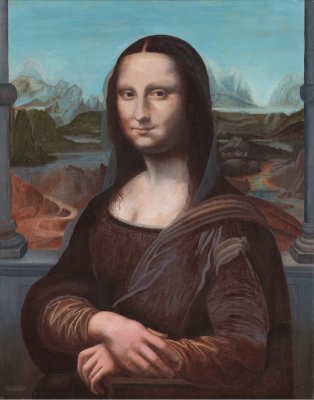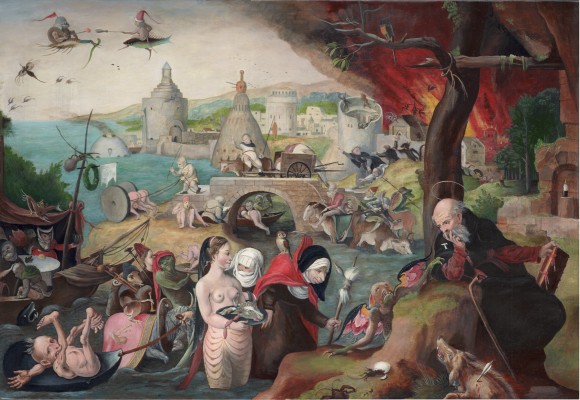I am a technical painter. I am not an artist in the modern sense.
I do not attempt to create original works.
I see myself as using the medium of oil paint to make facsimiles of important emblematic and alchemical images from old manuscripts, paintings and books, often restoring the images by removing the flaws that time has imposed onto these old artworks.
I now paint exclusively on board, having abandoned using canvas some years ago. I prefer the smooth finish of a board as I found the weave of the canvas was making it difficult for me to create detail. After a frustrating few months in 2002 when I tried to source very fine canvas, I suddenly realised the problems I was having could be solved by using smooth board. Early paintings, from the 15th century were created on wooden boards, and this allowed the artists of the time to use the medium of oil paint to make amazingly detailed paintings (the Arnolfini by Jan van Eyck being the best known example). The rise of the use of canvas from the 16th century onwards, perhaps changed painting, and from that time onwards paintings in general became less detailed, larger and intended to be viewed from a few paces away.
The paintings I produce are intended for the domestic space, rather than an art gallery, thus they are usually small in size. I usually work on paintings up to 18 by 12 inches and often smaller. They are intended to be viewed up close.
My subject matter is alchemical and emblematic, usually taken from alchemical manuscripts. These were originally created as coloured drawings on paper or parchment using water based paints or inks. I thus have to translate that into the medium of oils. From around 2009, as a change from alchemical emblems, I made restored copies of some wonderful Old Master paintings from the 15th, 16th and 17th century.
I now use alkyd oils exclusively. This is a relatively new range of artists oil paints by Windsor and Newton. They have the advantage of drying extremely quickly as they are based on an alkyd resin. I began experimenting with these back in 2004 and after a few months decided to move over to these exclusively as they made the task of painting so much easier for me. Previously I often found I could inadvertently damage areas of a painting when I worked on it a day or so later as the paint was still wet. Alkyds are touch dry often after only a few hours, which means one can return to work on a painting after being interrupted by other tasks, which unfortunately often happens to me.
Alkyds also are for the most part transparent, though there are a few exceptions such as Naples Yellow. This suits well my style as I use layer upon layer of thin paint to build up the final image. I almost never use a thick application of paint. Alkyds are very finely ground so there is no grittiness. Because of the transparency I use a white melamine pallette to mix the paints so one can see the colours. This has the advantage that is it is easy to scrape clean, which one has to do once one finishes work as the paint will dry if you leave your palette till the next day.
I begin painting using only white spirit as a thinner. Once I have built up a few layers and established the forms, I add the detail using an alkyd medium called Liquin with a little white spirit. Modelling forms can be easily done using thin glazes of the alkyd Burnt Sienna or Vandyke Brown, which are wonderfully translucent. Once the painting is finished I apply a few coats of liquin to smooth out any differences between areas. This gives the final painting a beautiful gloss surface on which one can apply a varnish to protect the image further.
I paint with very small brushes. I don't have any bristle brushes at all. I never would use such a brush. They do not make brushes for oil painting small enough for me, so I use ones intended for acrylics. I mostly use the Windsor and Newton Galeria range which are made from an artificial polyester fibre. I find they keep their profile for reasonably long periods when used with the more abrasive oils, though they are intended for use with acrylics. I usually wear out a couple of brushes on each painting. I use only the smaller brushes, 1, 0 and the smallest 00. I also have some Cotman brushes which go down to 0000 with very short bristles. These are for watercolours so don't last long but are essential for very fine work. The painting of the Splendor Solis (Old King and Young King) which I completed in March 2010 was made almost exclusively with a 0 and a 00 brush, both of which wore out and had to be replaced towards the end. Most people think me crazy to do this, but it is the way I work. To me painting with large flat bristle brushes would be like painting while wearing boxing gloves.
As alkyd oils dry quickly, early on I found that thoroughly cleaning ones brushes was essential, otherwise the paint would dry into the ferrule and then the brush would lose its elasticity and be impossible to work with. Cleaning with white spirit was not enough and I often found that brushes I thought I had cleaned well and left a few days were ruined. Last year I solved the problem by buying an ultrasonic cleaner intended for cleaning jewelry. I fill the tank with white spirit, then turn it on and merely hold the brush in the spirit for 20 or 30 seconds and all the particles of pigment are entirely removed by the ultrasonic shaking. I thus avoid grounding the brush and damaging its point.
I approach a painting as a technical exercise. I do not agonise or struggle with the piece. It is a matter of just working towards a finished detailed painting which is as close to the original as I can achieve. Technical painting is just a craft and hours and hours of painstaking work. I often learn from painting exactly how to achieve various effects using the alkyds and small brushes. The effect of representing light reflecting off glass or a polished surface, seems daunting at first but is relatively easy to create using a number of layers. I look at as many early paintings as I can in art galleries to try and discover how they were painted. Sometimes I get too close to the painting and find myself apprehended by the security. Once when I was in the National Gallery in London, I was trying to see the underpainting on a work by David Teniers. You can sometimes see this if you look at it from a very oblique angle and try to catch the light from a source above. I had a bit of explaining to do to the security guard!
To make a facsimile copy of a painting I need as high a quality photograph as possible from which to work. Ideally this should be size for size as the copy. This makes things much easier. Many of the illustrations from manuscripts are quite small and cannot be enlarged too much. If I attempt to paint an item too large then it does produce problems, as does shrinking a larger image too small for then the detail is below that which can be painted by brush. So choice of scale is crucial.
I work in a room with the curtains closed. Natural light is wonderful, but it is variable. If one paints under natural light then the colours will be perceived differently each time one works on a painting. Years ago I used to work in a large bay window, but was constantly frustrated by the varying light. Now I use two powerful metal halide floodlights mounted near the ceiling, both with high colour temperatures, and two tungsten daylight corrected bulbs close to the surface of the painting. This way the lighting is constant whatever the time of day, or the weather outside.
In 2009, as a change from alchemical emblems, I made restored copies of some wonderful paintings from the 15th, 16th and 17th century.




Later in 2009 I began work on the Temptation of St Anthony series, in which I will make copies of some key works in this genre, which fascinates me. This project will take about two years to complete.


See my new Art Weblog Paintings for sale at present
